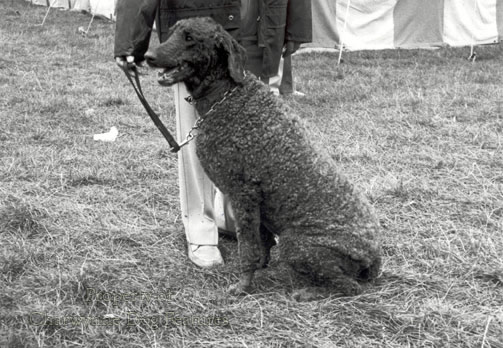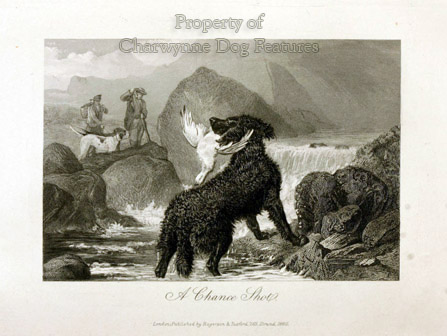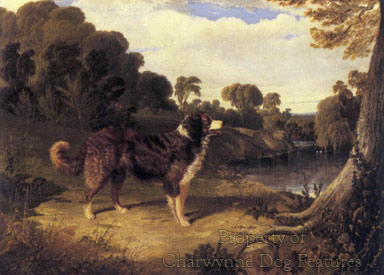107 DOGS FOR WATER
DOGS FOR WATER
by David Hancock
 Gundog breeds today are rightly revered and their breed type resolutely perpetuated. Sportsmen in early medieval times however knew the value of setting dogs and water dogs, the original retrievers, more than any of their successors. The invention of firearms did away with the need to recover arrows or bolts, as well as increasing the range at which game could be engaged. The setting dogs adapted from the net to the gun and survived, but the water dogs of Europe lost their value and many became ornamental dogs, like the Poodle. Some water dogs survive as breeds, with the Irish Water 'Spaniel' still causing discussion over whether it's a spaniel or a retriever. The similarity of the other extant water dog breeds is remarkable: the Wetterhoun of Holland, the Barbet of France, the Lagotto Romagnolo of Italy and the Spanish and Portuguese Water Dogs being easily confused. There is a difference between water dogs and water spaniels, mainly in the coat and head structure but also in their instinctive performance.
Gundog breeds today are rightly revered and their breed type resolutely perpetuated. Sportsmen in early medieval times however knew the value of setting dogs and water dogs, the original retrievers, more than any of their successors. The invention of firearms did away with the need to recover arrows or bolts, as well as increasing the range at which game could be engaged. The setting dogs adapted from the net to the gun and survived, but the water dogs of Europe lost their value and many became ornamental dogs, like the Poodle. Some water dogs survive as breeds, with the Irish Water 'Spaniel' still causing discussion over whether it's a spaniel or a retriever. The similarity of the other extant water dog breeds is remarkable: the Wetterhoun of Holland, the Barbet of France, the Lagotto Romagnolo of Italy and the Spanish and Portuguese Water Dogs being easily confused. There is a difference between water dogs and water spaniels, mainly in the coat and head structure but also in their instinctive performance.
The American Water Spaniel, now recognized by our Kennel Club, epitomizes the water spaniels with its marcelled coat and distinctly spaniel head. The Curly-coated Retriever displays the very individual astrakhan coat of the water dogs and the plainer head of the retrievers. This type of dog, quite often black, liver or parti-coloured, had one physical feature which set it apart from most others, the texture of its coat. It is so easy when looking at a Standard Poodle in show clip to overlook their distinguished and ancient sporting history. Anyone looking for a water retriever with instinctive skills, inherited prowess, a truly waterproof coat and freedom from faulty genes should look at the Standard Poodle, but be prepared for lighthearted derision from one-generation sportsmen, unaware of its heritage.
The Standard Poodle is a living example of the ancient waterdog, whose blood is behind so many contemporary breeds: the Curly-coated Retriever, Wetterhoun of Holland, Portuguese and Spanish Waterdogs, Lagotto Romagnolo, Pudelpointer, Barbet, Irish and American Water Spaniels and the Boykin Spaniel. The Tweed Water Spaniel was behind our hugely popular Golden Retriever. The old English Water Spaniel's coat sometimes emerges in purebred English Springers.
Although our breeds of retriever were not developed until comparatively recently, the use of dogs as retrievers by sportsmen is over a thousand years old. "Traine him to fetch whatsoever you shall throw from you...anything whatsoever that is portable; then you shall use him to fetch round cogell stones, and flints, which are troublesome in a Dogges mouth, and lastly Iron, Steele, Money, and all kindes of metall, which being colde in his teeth, slippery and ill to take up, a Dogge will be loth to fetch, but you must not desist or let him taste food till he will as familiarly bring and carry them as anything else whatsoever." So advised the rural life chronicler (and prolific plagiarizer) Gervase Markham, drawing on earlier writers, around 1620, on the subject of training a 'Water Dogge' to retrieve.
Half a century earlier, the much quoted scholar Dr. Caius, in his De Canibus Britannicus, identified the curly-coated Water Dogge as "bringing our Boultes and Arrowes out of the Water, which otherwise we could hardly recover, and often they restore to us our Shaftes which we thought never to see, touch or handle again." Such water-dogs were utilised on the continent too; in 'The Sketch Book of Jean de Tournes', published in France in 1556, we see illustrated 'The Great Water Dogge', a big black shaggy-headed dog swimming out to retrieve a duck from a lake. This sketch could so easily have been of the contemporary Barbet, still available in France, acknowledged as an ancient type, and used to infuse many sporting breeds with desirable water-dog characteristics. The dog depicted could also represent the modern Cao de Agua, the Portuguese Water Dog. These European water-dogs are the root stock of so many modern breeds.
Not surprisingly such dogs were favoured by the sea-going fraternity, fishermen, sailors and traders. The dogs were trained to retrieve lines lost overboard and used as couriers between ships, in the Spanish Armada for example. In time, such dogs featured in the settlements established along the eastern sea-board of the New World by British, Portuguese, Dutch and French traders. Water-dogs exist today in those countries: the Barbet in France, the Wetterhoun in Holland, the Curly-coated Retriever and the Irish Water 'Spaniel' here and the Portuguese Water Dog there. The latter, still favoured by fishermen in the Algarve, has either a long harsh oily coat or a tighter curly coat. The Barbet has the long coat, the Wetterhoun the curly coat.
Of these three, the most distinctive is the Cao de Agua, now gaining strength in this country. An ancient Portuguese breed which can be traced back to very remote times, it has some similarity with the Spanish Water Dog, now being restored to that country's list of native breeds and the Italian Water Dog, the Lagotto Romagnolo, also being resurrected. Overseas kennel clubs do, unlike ours, try to conserve their national canine heritage. There is evidence that such breeds were regarded as sacred in pre-christian times, any person killing a water-dog being subject to severe penalty. The highly individual water-dog clip led to the Romans referring to such dogs as Lion Dogs. This clip, with the bare midrift and hindquarters but featuring a plumed tail, does give a leonine appearance. The modern toy breed, the Lowchen (meaning lion-dog) displays this clip and is a member of the small Barbet or Barbichon (nowadays shortened to Bichon) group of dogs, embracing the Bolognese, the Havanese, the Maltese, the Bichon a poil frise and the Coton du Tulear. 
The Poodle of today came directly from the curly-coated variety of water-dog, as indeed less directly did the Curly-coated Retriever, the Wetterhoun and the surviving water spaniels. Seen nowadays as a non-sporting dog, the Poodle has a creditable sporting pedigree -- the Dorset sportsman the Rev. Harold Browne's retrieving Poodles being much admired at the start of the 20th century. The Germans referred to such a dog as a Pudel; the French spoke of a Canne Chien or Duck Dog, which became in time Caniche, the modern French name for a poodle, whilst the Russians wrote of a Pod-laika, laika meaning a bark-pointer, like the Finnish Spitz.
The advent of firearms led to many changes in the use of dogs in the hunting of feathered game. No longer were the dogs just required to bring back the valuable arrows or bolts but expected to retrieve shot game on land as well as from water. The finding of shot game on land, especially as the range of munitions increased, demanded top quality scenting powers, the persistence of a hound and the biddable qualities of a sheepdog. In due course, the breeds of land spaniel developed alongside the water spaniels, which usually had a high proportion of water-dog blood, as their coat texture revealed.
The dark liver is the classic water-dog colour, as the American and Irish Water Spaniels, the Wetterhoun and the Lagotto display today. The Wetterhoun, once famed as an otter-hunter, and the Lagotto, still famous as a truffle-finder, also feature liver and white, as our own now extinct water spaniel did. In 1621, Gervase Markham was recording: "First, for the colour of the best Water Dogge, all be it some which are curious in all things will ascribe more excellency to one colour than to another as the Blacks to be the best and hardest; the lyver hued swiftest in swimming...and his hairs in generall would be long and curled..." It is of interest that the Newfoundland, once described as the Great Retriever, was depicted by Ben Marshall in his well-known painting of 1811 as being black and white and covered in small tight curls.
The black or liver Curly-coated Retriever was described by breed-expert LPC Astley, writing in 1907, of their distinctive coats as the only "true and proper one...of which every knot is solid and inseparable. A coat of this quality is not capable of improvement by any methods of grooming, for the simple reason that its natural condition is itself perfect. The little locks should be so close together as to be impervious to water and all parts of the body should be evenly covered with them, including the tail and legs." This astrakhan coat is the perfect counter to 'mongrelisation' in a curly-coated breed, for unless the unique coat is inherited, the product isn't a member of the tribe. 
I have seen pure-bred Labradors feature a curly coat and we have all seen English Springer Spaniels with very curly coats. I suspect the linty coat of the distinctive Bedlington Terrier owes its origin to water-dog blood, perhaps that of the Tweed Water Spaniel, once known in the area where the Bedlington was developed. The early Airedale Terriers, bred originally as waterside terriers in the Aire valley, had noticeably curly coats; this is now frowned on, the word crinkle-coated being preferred. The now extinct Llanidloes Setter featured this tight, densely-curled, waterproof coat. The Tweed Water Spaniel blood in the Golden Retriever is however not only acknowledged but prized. Our ancestors knew the value of water-dog blood.
It may not suit the misplaced pride of the shooting man of today to acknowledge the blood of poodle-like dogs in his working gundogs or associate such dogs with his desired image. I see it as a matter of gratitude more than anything else. It may be difficult to accept a shared origin between a strapping Curly and a toy Poodle, a sturdy Wetterhoun and a diminutive bichon and a lion-clipped tiny Lowchen and a whiptail. But, as the Chihuahua and the Great Dane dramatically illustrate, different purpose has led to different development; ornamental dogs are expected to be small, retrievers have to have substance and stamina.
The liver and the black coat colours of the ancient water-dogs and their unique curly texture have survived and surfaced in many of today's breeds, whether sporting or non-sporting in use. Their fondness for and durability in water lives on too, whether the breed is linked to Ireland or Holland, Italy or Spain, France or Portugal, America or Britain. Water-dogs are the rootstock of many of our sporting breeds whether they have lost or retained the typical coat texture and colours of their distant ancestors. The water-dogs of Europe have contributed a great deal to our sporting heritage and more should be made of the debt we owe them, in breed histories for example. May those of Italy and Spain, now saved from extinction, go from strength to strength. Time to restore our Tweed Water Spaniel or our English Water Spaniel?